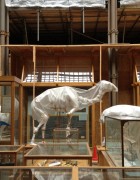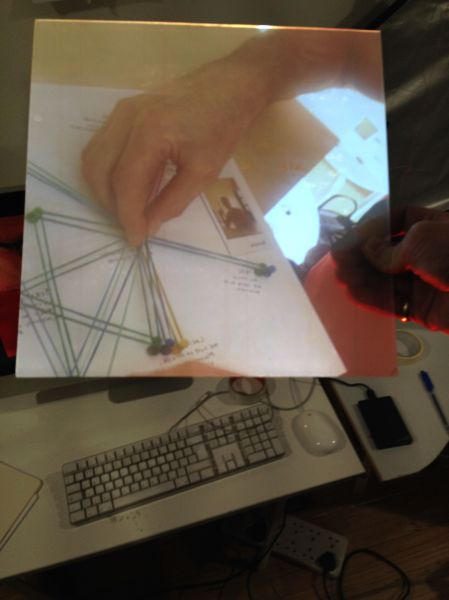For last week’s work in progress show, working with Shobhan Shah, I put together an interactive installation that was designed to be a digital/physical video player. The basic idea is that the nodes in a network become buttons that trigger video footage of someone talking about the particular relationship represented by that node. So as you press on the buttons wether in a specific sequence or not you get the story of a specific social network. This gets at some important elements of my research – that social networks embody the very human qualities of personal relationships and that one important way of understanding these relationships is by recounting or telling stories about them. In order to view the video it needed to be back projected – you can’t stick physical pins into a monitor. It was important to me that the proportions of the network substrate were identical to the original. I sourced some frosted perspex and pointed a Pico projector at it to find out what the minimum projection distance would be to achieve the image size required. This distance then dictated the height of the resulting plinth on top of which the perspex sheet sat. The next challenge was to drill holes in the perspex sheet in the same configuration as the original tile, stick buttons behind the holes and mount cork plugs robust enough to hold a coloured push pin in place but still allow for the detent on the button beneath.
Of course we soon discovered that back projecting an image onto a sheet of plastic has focus issues. The projected light passes through the lower surface but is diffused by the frost in the centre to result in a soft image on the front surface. We never discovered the workaround to this problem but my colleague Michaela French came up with a brilliant solution. For her own exhibit she projected onto small sheets of transparent perspex that had only one surface frosted by laser cutting a shallow engrave over the entire surface. Great thinking through materials and a real why-didn’t-we-think-of-that? moment. All our buttons had to be connected to an Arduino at floor level 1 metre away in order to interface with a mac mini hidden in the base of the plinth. The issue then became how to stop the wires from creating sharp shadows on the image. After much fiddling and sticking eventually we got all the wires out of the way and stretching away internally down to the base of the plinth. The final setup was then a projector mounted at floor level, pointing upwards to a projection surface which had back mounted buttons onto which brass tubes containing cork plug were glued. These mounted into the perspex such that they were flush with the upper surface. Of course back projected images are reversed so we had to fix that and make sure the entire surface was covered by the projected image not leaving any black borders or misaligned videos.
This tangling with physical materials, what Ingold calls correspondence, involved dealing with MDF panels, perspex sheets, push pins, tiny buttons, brass tubes, cork sheets, and ultra-fine filament copper wires, all arranged in a finely balanced configuration of elements intended to deliver a specific experience. The processes associated with these physical materials -stripping and wrapping wires, sawing, cutting, drilling, glueing, clamping, painting, and soldering all unfolded in a careful sequence of planned actions. In some way the materials are inseparable from the processes necessary to shape them into their final forms. Many other and different processes are of course possible, but the nature of our design meant a very detailed and particular ordering of materials and processes. I’m calling this contextual gestalt, meaning the putting together of various materials in a series of fixed physical and compositional relationships with each other, intended to result in a pre-conceived expressive placing.
A very particular form of material synthesis is created when in active correspondence with digital materials, In this example the digital materials consisted of; HD video edited to carefully trimmed snippets, their associated soundtracks, a processing sketch to control the relationships between pins, buttons and wires, and the operating code of the Arduino micro-processor to which the wires, and resistors were attached. Digital video is notoriously difficult to work with. Diverse compression algorithms have wildly different effects on playback and sound quality, reversing the footage to be back projected involved exporting them to a completely new application, file format standards vary across applications, and computer playback depends on the graphics processor unit of the target device. While they are cheap prototyping tools, and allow for creative experimentation on a revolutionary scale Arduino micro-processors are also prone to failure, can often feature power supply problems and not well suited to long lasting public interactions. Luckily our circuit was very simple, the videos very short and the exhibit only on show for 5 days.
The overall synthesis of digital materials with physical materials involves very different design and making skills and it is rare to find people equally proficient. While I am comfortable in a physical workshop, working with manipulable tools, I did rely on Shobhan for the Processing and Arduino elements. In fact many of these types of digital/physical works are made in teams of people with complementary skills. The real challenge in this field is integrating the smooth, nano-second speed, invisible processes, and dematerialised interactions of the digital with the messy tasks of glueing, sawing, clamping and sticking of the physical world. Add in the unpredictable and ultimately chaotic nature of human behaviour and the resulting opportunity for surprise, delight, failure, and revelation through design can be rewarding.


